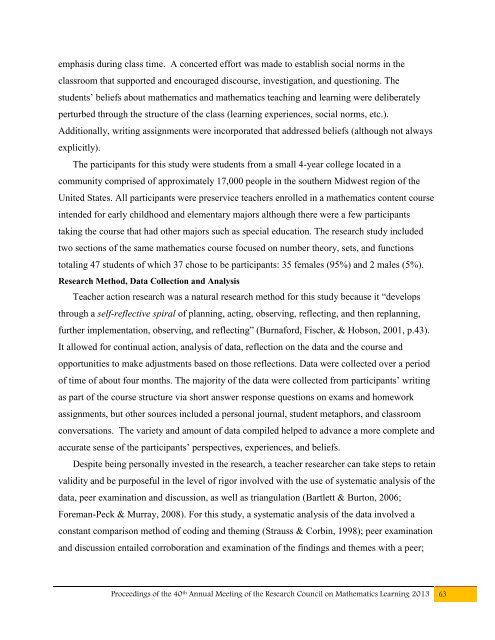2013 Conference Proceedings - University of Nevada, Las Vegas
2013 Conference Proceedings - University of Nevada, Las Vegas
2013 Conference Proceedings - University of Nevada, Las Vegas
- No tags were found...
Create successful ePaper yourself
Turn your PDF publications into a flip-book with our unique Google optimized e-Paper software.
emphasis during class time. A concerted effort was made to establish social norms in theclassroom that supported and encouraged discourse, investigation, and questioning. Thestudents’ beliefs about mathematics and mathematics teaching and learning were deliberatelyperturbed through the structure <strong>of</strong> the class (learning experiences, social norms, etc.).Additionally, writing assignments were incorporated that addressed beliefs (although not alwaysexplicitly).The participants for this study were students from a small 4-year college located in acommunity comprised <strong>of</strong> approximately 17,000 people in the southern Midwest region <strong>of</strong> theUnited States. All participants were preservice teachers enrolled in a mathematics content courseintended for early childhood and elementary majors although there were a few participantstaking the course that had other majors such as special education. The research study includedtwo sections <strong>of</strong> the same mathematics course focused on number theory, sets, and functionstotaling 47 students <strong>of</strong> which 37 chose to be participants: 35 females (95%) and 2 males (5%).Research Method, Data Collection and AnalysisTeacher action research was a natural research method for this study because it “developsthrough a self-reflective spiral <strong>of</strong> planning, acting, observing, reflecting, and then replanning,further implementation, observing, and reflecting” (Burnaford, Fischer, & Hobson, 2001, p.43).It allowed for continual action, analysis <strong>of</strong> data, reflection on the data and the course andopportunities to make adjustments based on those reflections. Data were collected over a period<strong>of</strong> time <strong>of</strong> about four months. The majority <strong>of</strong> the data were collected from participants’ writingas part <strong>of</strong> the course structure via short answer response questions on exams and homeworkassignments, but other sources included a personal journal, student metaphors, and classroomconversations. The variety and amount <strong>of</strong> data compiled helped to advance a more complete andaccurate sense <strong>of</strong> the participants’ perspectives, experiences, and beliefs.Despite being personally invested in the research, a teacher researcher can take steps to retainvalidity and be purposeful in the level <strong>of</strong> rigor involved with the use <strong>of</strong> systematic analysis <strong>of</strong> thedata, peer examination and discussion, as well as triangulation (Bartlett & Burton, 2006;Foreman-Peck & Murray, 2008). For this study, a systematic analysis <strong>of</strong> the data involved aconstant comparison method <strong>of</strong> coding and theming (Strauss & Corbin, 1998); peer examinationand discussion entailed corroboration and examination <strong>of</strong> the findings and themes with a peer;<strong>Proceedings</strong> <strong>of</strong> the 40 th Annual Meeting <strong>of</strong> the Research Council on Mathematics Learning <strong>2013</strong> 63




